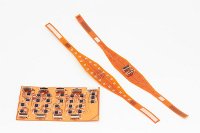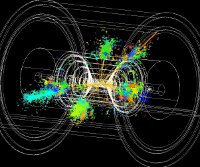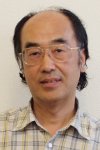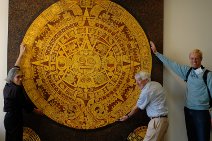 |
|
|
 |
New type of thermal sensors for vertical testing of nine-cell cavities for the ILC

New thermal sensor components. Two sensing units on the right and a switching circuit on the left. |
Scientists at Kyoto university are testing a new type of thermal sensor for superconducting cavities on the vertical test for ILC at the Superconducting radiofrequency Test Facility (STF) at KEK. This sensor is under development by a Kyoto-KEK collaboration The team is developing this new device to address issues in the components of the sensor – tangled wires and resistors. At STF, a carbon resistor is used for vertical testing of nine-cell cavities. They have already installed 350 sensors on the outer surface of the nine-cell cavity, and 700 lead wires were needed to connect both ends of sensors through cryogenic area and outside, in order to measure the temperature. “For a shorter developing time, I have chosen carbon resistor which is technologically proven in the past superconducting cavity R&D. This structure is simple, not so sophisticated.” said Yasuchika 'Kirk' Yamamoto, the scientist at KEK who designed the present system. When the cavity is being tested, it is cooled to 2 kelvins, and has to stay at that temperature as much as possible. In general, it is best to use the smallest possible number of lead wires to prevent heat invasion to the cryogenic area. “The current system needs too many lead wires, and the production of the carbon resistor has been discontinued, we thought we should develop a new thermal sensor to replace it,” he said.
Read more...
-- Yutaka Nagakubo (KEK) |
 |
|
|
 |
Upcoming meetings, conferences, workshops
CLIC09 Workshop
CERN
12-16 October 2009
12th International Conference On Accelerator And Large Experimental Physics Control Systems (ICALEPCS 2009)
Kobe International Conference Center, Kobe, Japan
12-16 October 2009
EUDET Annual Meeting
University of Geneva and CERN, Geneva, Switzerland
19-21 October 2009
FCAL Collaboration Meeting
CERN, Geneva, Switzerland
21-22 October 2009
2009 IEEE Nuclear Science Symposium and Medical Imaging Conference
Orlando, Florida, USA
25-31 October 2009
|
|
|
GDE Meetings calendar
View complete ILC calendar
|
|
|
 |
 |
|
|
 |
Linear developments
New detector R&D group at CERN looks for synergies with ILC

Simulation of an e+e- event at a centre-of-mass energy of 3 TeV in which a heavy supersymmetric Higgs particle of 1.1 TeV is created. |
The new group for linear collider detector development at CERN is less than a year old, but it is growing fast: a number of students and fellows are already working on simulations, and as of next year there will be funds for actual hardware development. The linear collider detector R&D group (LCD) is led by Lucie Linssen. As a group based at CERN, home of the Compact Linear Collider study CLIC, its main focus is on detectors that record the collisions that CLIC would produce. At three TeV these have a much higher energy than the
500-GeV collisions at the ILC, higher backgrounds and very different timing: whereas there are 340 nanoseconds between two particles bunches colliding in the ILC, at CLIC the plan is to have electron-positron collisions every half a nanosecond.
Read more...
-- Barbara Warmbein |
 |
|
|
 |
From Cern Bulletin
5 October 2009
The Latest from the LHC: Towards the big chill
With 6 sectors out of 8 at nominal cryogenic temperature (1.9 K= about -271 °C), the commissioning at the LHC is progressing well. According to the present schedule, the whole machine will be cold in about two weeks.
Read more... |
|
From Physics Today
5 October 2009
UK prepares for tough science funding environment
An article in the London Times that suggesting the UK was considering pulling out of the CERN has caused consternation in the physics community, and denials from the Science and Technology Facilities Council (STFC), but a review of the UK's science expenditure is ongoing.
Read more... |
|
From University of Oxford and Royal Holloway University of London
2 October 2009
New director for John Adams Institute
...Andrei Seryi will be the next Director of the John Adams Institute for Accelerator Science (JAI), (...) currently leading the work on the Facilities for Accelerator Science and Experimental Test Beams at SLAC (...), as well as being the leader of the Beam Delivery System for the International Linear Collider. Professor Seryi is also deputy spokesperson for the Accelerator Test Facility collaboration, based in Japan.
Read more... |
|
From Cern Courier
30 September 2009
The future is together
As R&D makes progress on ideas for a future e+e– collider to explore particle physics at the terascale, recent events at CERN are paving the way towards a common, worldwide linear-collider community in the areas of accelerators and detectors.
Read more... |
|
|
 |
Toshiaki Tauchi, a would-be rocket scientist, joins the GDE Executive Committee

Toshiaki Tauchi (KEK), the newest member of the GDE Executive Committee |
The expansion of the Global Design Effort Executive Committee (EC) is complete. Today I announce that Toshiaki Tauchi has accepted my invitation and has joined the EC. I enthusiastically welcome him! I first announced my intent to expand the EC by three members last spring in order that we have the breadth of knowledge and skills needed to make informed decisions on both technical and policy issues during the next phase of our activities. Toshiaki is well known within the ILC R&D activities and has been a mainstay of our critical work on interface issues between the accelerator and detectors.
Read more...
-- Barry Barish
Director's Corner Archive |
Impressions from Albuquerque

|
|
arXiv preprints
0910.0359
Card game restriction in LHC can only be successful!
0909.5323
W physics at the ILC with polarized beams as a probe of the Littlest Higgs Model
|
|

